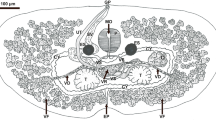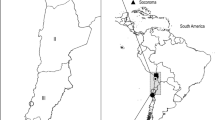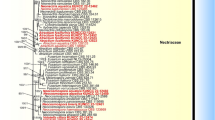Abstract
Probolocoryphe species occur primarily as intestinal parasites of birds and mammals. Infection of the crab Nanosesarma minutum with the metacercarial cyst stages of Probolocoryphe uca is common in Kuwait Bay. In this study, the snail Cerithidea cingulata was used to determine if it would serve as first intermediate host in the parasite’s life cycle. To determine the snail–crab link in the life cycle of P. uca based on rDNA molecular data, ribosomal internal transcribed spacer (ITS) regions of the metacercarial cyst stage from the crab N. minutum and the sporocyst stage from the snail C. cingulata were sequenced and compared. Sequence alignment clearly demonstrated that the sporocysts and metacercariae belonged to P. uca. Comparisons were also made between the ITS sequences of P. uca and other digenean species available in GenBank. NCBI databases were used for sequence homology analysis using BLAST, ClustalW, and MUSCLE. The phylogenetic trees based on the homology analysis of the ITS (1 and 2) sequences constructed using PHYLIP and MEGA 4.0 confirmed the identification and positioned P. uca in the Microphallidae family.







Similar content being viewed by others
References
Abdul-Salam J, Sreelatha BS (1998) A list of larval digenetic trematodes parasitizing some marine invertebrates of Kuwait Bay. Kuwait J Sci Eng 25:409–434
Abdul-Salam J, Sreelatha BS (2000) Surface morphology of Probolocoryphe uca (Sarkisian, 1957) (Digenea: Microphallidae) from Kuwait Bay. Syst Parasitol 46:209–214
Adlard RD, Barker SC, Blair D, Cribb TH (1993) Comparison of the second internal transcribed spacer (ribosomal DNA) from populations and species of Fasciolidae (Digenea). Int J Parasitol 23:423–425
Al-Kandari MA, Abdul-Salam MA, Moussa MA, Sreelatha BS (2007) Seasonal dynamics of the cercarial and metacercarial stages of the microphallid trematode Maritrema eroliae (Digenea: Microphallidae). Acta Zoologica Sinica 53(3):463–469
Barber KE, Mkoji GM, Loker ES (2000) PCR-RFLP analysis of the ITS2 region to identify Schistosoma haematobium and S. bovis from Kenya. Am J Trop Med Hyg 62:434–440
Bartoli P, Jousson O, Russell-Pinto F (2000) The life cycle of Monorchis parvus (Digenea: Monorchiidae) demonstrated by developmental and molecular data. J Parasitol 86:479–489
Blair D, Campos A, Cummings MP, Laclette JP (1996) Evolutionary biology of parasitic helminthes: the role of molecular phylogenetics. Parasitol Today 12:66–71
Blair D, Agatsuma T, Watanobe T, Okamoto M, Ito A (1997a) Geographical genetic structure within the human lung fluke Paragonimus westermani, detected from DNA sequences. Parasitology 115:411–417
Blair D, Agatsuma T, Watanobe T, Okamoto M, Ito A (1997b) Molecular evidence for the synonymy of three species of Paragonimus, P. ohirai Miyazaki, 1939, P. iloktsuenensis Chen 1940 and P. sadoensis Miyazaki et al, 1968. J Helminthol 71:305–310
Bush AO, Heard RW, Overstreet RM (1993) Intermediate hosts as source communities. Can J Zool 71:1358–1363
Cable RM (1956) Marine cercariae of Puerto Rico. Scientific survey of Puerto Rico and the Virgin Islands. New York Acad Sci 16:490–577
Chevenet F, Brun C, Banuls AL, Jacq B, Christen R (2006) TreeDyn: towards dynamic graphics and annotations for analyses of trees. BMC Bioinformatics 7:439
Deblock S (2008) Family Microphallidae Ward, 1901. In: Bray RA, Gibson DI, Jones A (eds) Keys to the Trematoda, vol 3. CABI Publishing and the Natural History Museum, Wallingford, pp 451–492
Després L, Imbert-Establet D, Combes C, Bonhomme F (1992) Molecular evidence linking hominid evolution to recent radiation of schistosomes (Platyhelminthes: Trematoda). Mol Phylogenet Evol 1:295–304
Edgar RC (2004) MUSCLE: multiple sequence alignment with high accuracy and high throughput. Nucleic Acids Res 32(5):1792–1797
Felsenstein J (1989) PHYLIP–Phylogeny Inference Package (Version 3.2). Cladistics 5:164–166
Galaktionov K, Skirnisson K (2007) New data on Microphallus breviatus Deblock and Millard 1975 (Microphalidae: Digenea) with emphasis on the evolution of dixenous life cycles of microphallids. Parasitol Res 100:963–971
Guindon S, Gascuel O (2003) A simple, fast and accurate algorithm to estimate large phylogenies by maximum likelihood. Syst Biol 52:696–704
Guk S, Chai J, Sohn W, Kim Y, Sim S, Seo M (2008) Microphallus koreana n. sp. (Trematoda: Microphallidae) transmitted by a marine crab, Macrophthalmus dilatatus. Korean. J Parasitol 46(3):165–169
Heard R, Sikora W (1969) Probolocoryphe otagaki, 1958 (Trematoda: Microphallidae), a senior synonym of Mecynophallus Cable, Conner and Balling, 1960, with notes on the genus. J Parasitol 55:674–675
Hust J, Frydenberg J, Sauriau P, Le Gall P, Mouritsen K, Jensen K (2004) Use of ITS rDNA for discriminating of larval stages of two microphallid (Digenea) species using Hydrobia ulvae (Pennant, 1777) and Corophium volutator (Pallas, 1766) as intermediate hosts. Parasitol Res 93:304–310
Kane RA, Rollinson D (1994) Repetitive sequences in the ribosomal DNA internal transcribed spacer of Schistosoma haematobium, Schistosoma intercalatum and Schistosoma mattheei. Mol Biochem Parasitol 63:153–156
Kane RA, Ridgers IL, Johnston DA, Rollinson D (1996) Repetitive sequences within the first internal transcribed spacer of ribosomal DNA in schistosomes contain a Chi-like site. Mol Biochem Parasitol 75:265–269
Kinesella J (1988) Comparison of helminthes of rice rats, Oryzomys palustris, from freshwater and saltwater marshes. Proceedings of Helminthological Society of Washington 55:275–280
Lafferty K, Dunham E (2005) Trematodes in snails near raccoon latrines suggest a final host role for this mammal in California salt marshes. J Parasitol 92(2):474–476
Schell SC (1985) Handbook of trematodes of North America north of Mexico. University of Idaho Press, Moscow, Idaho
Seo M, Guk S, Lee S, Chai J (2007) Gynaecotyla squatarolae (Digenea: Microphallidae) from rats experimentally infected with metacercariae from the shore crab, Macrophthalmus dilatatus. Korean J Parasitol 45(3):199–204
Seo M, Guk S, Lee S, Chai J (2008) The ruddy turnstone, Arenaria interpres, a new definitive host for Gynaecotyla squatarolae (Digenea: Microphallidae). Korean J Parasitol 46(1):41–43
Tamura K, Dudley J, Nei M, Kumar S (2007) MEGA4: Molecular Evolutionary Genetics Analysis (MEGA) software version 4.0. Mol Biol Evol 24:1596–1599
Thompson J, Higgins DG, Gibson T (1994) CLUSTAL W: improving the sensitivity of progressive multiple sequence alignment through sequence weighting, positions-specific gap penalties and weight matrix choice. Nucleic Acids Res 22:4673–4680
Van Herwerden L, Blair D, Agatsuma T (1998) Intra- and inter-specific variation in nuclear ribo2somal internal transcribed spacer 1 of the Schistosoma japonicum species complex. Parasitology 116:311–317
Van Herwerden L, Blair D, Agatsuma T (1999) Intra- and inter-individual variation in ITS of Paragonimus westermani (Trematoda: Digenea) and related species: implications for phylogenetic studies. Mol Phylogenet Evol 12:67–73
Vilas R, Criscione C, Blouin M (2005) A comparison between mitochondrial DNA and the ribosomal internal transcribed regions in prospecting for cryptic species of platyhelminth parasites. Parasitology 131:1–8
Waikagul J (1991) Intestinal fluke infections in Southeast Asia. Southeast Asian J Trop Med Public Health 22:158–162
Acknowledgement
This work was supported by Kuwait University Research Grant No. [SL08/08, ZS01/08]. Authors extend their deepest appreciation and gratitude to Prof. Jasem Abdul-Salam of the Department of Biological Sciences, Kuwait University, for providing timely suggestions and to Dr. R. A. Bray of the Department of Zoology, The Natural History Museum, London, for reviewing parts of the manuscript. Authors also gratefully acknowledge Mrs. Babitha Annice George for the technical assistance provided. Molecular analysis was performed with the support of the General Facility Project (GS 01/02) in the use of the ABI 3130xl Gene Analyzer at Biotechnology Center, Faculty of Science, Kuwait University.
Author information
Authors and Affiliations
Corresponding author
Rights and permissions
About this article
Cite this article
Al-Kandari, W.Y., Al-Bustan, S.A. Molecular identification of Probolocoryphe uca (Sarkisian, 1957; Digenea: Microphallidae) from Kuwait Bay using ITS1 and ITS2 sequences. Parasitol Res 106, 1189–1195 (2010). https://doi.org/10.1007/s00436-010-1778-1
Received:
Accepted:
Published:
Issue Date:
DOI: https://doi.org/10.1007/s00436-010-1778-1




